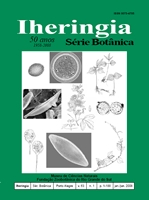Amphora tumida Hustedt (Bacillariophyceae) from southern Brazil
Palabras clave:
diatomácea psâmica, água saloba, taxonomia, ultra-estrutura.Resumen
The ultra-structure details and ecology of Amphora tumida Hustedt are presented. The species was found alive on sand grains in a brackish environment, in pH ranging from 5.5 to 7.4, and the electrical conductivity from 98 to 7,200 μS/cm. It is a rare diatom in the Laranjal Baywhere its frequency varies from 0.21 to 2.93%. Its morphology is in agreement with the type
material. It is the first report of Amphora tumida in South America since it was described for the first time.
Descargas
Citas
ANONYMOUS. 1975. Proposals for a standardization of diatom terminology and diagnoses. Nova Hedwigia, Beihefte, v. 53, p. 323-354.
ARCHIBALD, R.E.M. 1983. The diatoms of the Sundays and Great Fish Rivers in the eastern Cape Province of South Africa. Bibliotheca Diatomologica, v. 1. p. 1-362.
ARCHIBALD, R.E.M. & SCHOEMAN, F.R. 1984. Amphora coffeaeformis (Agardh) Kützing: a revision of the species under light and electron microscopy. South African Journal of Botany, v. 3, p. 83-102.
BARBER, H.G.; HAWORTH, E.Y. 1981. A guide to the morphology of the diatom frustule. Cumbria: Freshwater Biological Association.112p. (Scientific Publication, 44)
CLAVERO, E.; GRIMALT, J.O. & HERNÁNDEZ-MARINÉ, M. 2000. The fine structure of two small Amphora species. A. tenerrima Allem & Hustedt and A. tenuissima Hustedt. Diatom Research, v. 15, p. 195-208.
HUSTEDT, F. 1956. Diatomeen aus dem Lago de Maracaibo in Venezuela. Ergebnisse der deutschen limnolodischen Venezuela-Expedition 1952, v. 1, p. 93-140.
MAIDANA, N.I. 1994. Fossil diatoms from Salinas Del Bebedero (San Luis, Argentina. Diatom Research, v. 9, p. 99- 119.
RAMB. 2003. Relatório Anual da Qualidade Ambiental do Municipal de Pelotas 2002. 293pp. Secretaria de Qualidade Ambiental, Pelotas www.pelotas.com.br/secretarias/sqa. acesso em 03.03.2004.
ROUND, F.E., R.M. CRAWFORD & D.G. MANN. (1990). The diatoms. Biology and morphology of the genera. Cambridge University Press, Cambridge. 747 p.
ROSS, R.; COX, E.F.; KARAYEVA, N.I.; MANN, D.G.; PADDOCK, T.B.B.; SIMONSEN, R. & SIMS, P. A. 1979. An amended terminology for the siliceous components for the diatom cell. Nova Hedwigia, Beihefte, v. 64, p. 513-533.
SALA, S.E.; SAR, E.A. & FERRARIO. M.E. 1998. Review of materials reported as containing Amphora coffeaeformis (Agardh) Kützing in Argentina. Diatom Research, v. 13, p. 323-336.
SAR, E. A., S. E.SALA, F. HINZ & I. SUNESEN. 2003. Revision of Amphora holsatica (Bacillariophyta). European Journal of Phycology, v. 38, p. 73-81.
SAR, E.A.; SALA. S.E. HINZ, F. & SUNESEN, I. 2004. An emended description of Amphora tumida Hustedt (Bacillariophyceae). Diatom Research, v. 19, p. 71-80.
SCHOEMAN, F.R. 1972. A further contribution to the diatom flora of sewage enriched waters in southern Africa. Phycologia, v. 11, p. 239-245.
SIMONSEN, R. 1974. The diatom plankton of the Indian Ocean Expedition of R/V “Meteor”. Meteor Forsch.-Ergebnisse, v. 19 (D), p. 1-107.
TOLDO, E.E.; ALMEIDA, L.E.S. & CORRÊA, I.C.S. 2003. Forecasting shoreline changes of Lagoa dos Patos Lagoon, Brazil. Journal of Coastal Research, SI, 35: 43-50.







